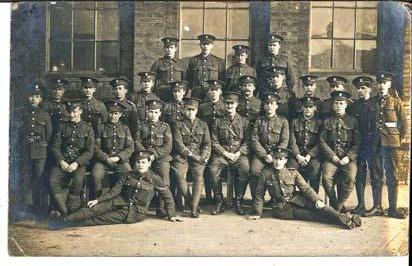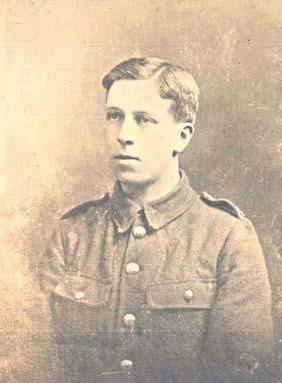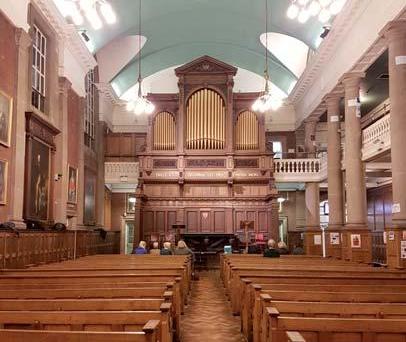
4 minute read
We Will Remember Them
from ONA 104
A TALE OF TWO COMRADES IN ARMS
If I should die, think only this of me: That there’s some corner of a foreign field That is for ever England. There shall be In that rich earth a richer dust concealed; A dust whom England bore, shaped, made aware, Gave, once, her flowers to love, her ways to roam, A body of England's, breathing English air, Washed by the rivers, blest by suns of home.
Advertisement
And think, this heart, all evil shed away, A pulse in the eternal mind, no less Gives somewhere back the thoughts by England given; Her sights and sounds; dreams happy as her day; And laughter, learnt of friends; and gentleness, In hearts at peace, under an English heaven.
The Soldier by Rupert Brooke
With the rededication of the iconic School Organ at a special service on Sunday 11 November 2018, it is of immense relevance to relate the poignant story of two ONs, one who fell at the Somme in March 1918, aged 21, buried in Pozieres Cemetery, near the battlefield in France, his name commemorated on the Organ with 277 others, who fell in both World Wars.
His fellow ON who survived the slaughter of Passchendaele in rural Belgium and returned to lead a most fulfilling life in northern England until his death in 1972.
A poignant display was set up by Sarah Huck, Library Assistant, with the support of Genny Silvanus, Archivist, and Jane Richardson, Librarian in the School Library.




Top to bottom: The newly regilded School Organ, Main Hall Neville Hind William Gaston Duval Hall 6th Battalion Northumberland Fusiliers, circa 1918 Neville was educated at the RGS and in 1917 he was awarded an exhibition (scholarship) to enter Sidney Sussex College, Cambridge. However, he enlisted at the Newcastle Barracks on 28 February 1917 before taking up his place at Cambridge and was posted to 3rd Northumberland Fusiliers at West Boldon. On 10 June he was transferred to 1st Lancashire Fusiliers. He was then wounded on 9 October and admitted to Wharncliffe War Hospital in Sheffield, where he wrote an account of his experience in France. There is a copy of this book in the School Archives and at the Imperial War Museum, and it has been referenced in Paul Ham’s book Passchendaele: Requiem for Doomed Youth. He was discharged from hospital in April 1918 and had various postings in the north of England until he was demobilised in January 1919. He was presented with the Military Medal by the Lord Mayor of Newcastle on 14 May 1918.
After the War, he took up his exhibition at Cambridge, obtaining an Honours degree in History, and then trained as a teacher. He married Dora Maughan of Gosforth in Newcastle in 1923 and they had one daughter, Dorothy, who kindly donated the Hind Papers to the school in 2006. In 1933 he was appointed to the post of Headmaster at Keighley Grammar School, where he remained until his retirement in 1958.







Neville Hind Memoir
‘A soldier carries all his stuff on his back. Full marching order is as follows:- Army boots, socks, trousers, tunic, puttees, cap, pants, cardigan (if not in pack) shirt, belt, braces, pouches with ammunition, sandbags, rifle, bayonet on scabbard, entrenching tool and handle, water bottle, haversack, iron rations (emergency rations) day’s rations, valise (containing overcoat, change of underclothing, extra socks, shaving tackle and other extras) oil sheet, steel helmet, two gas helmet… When you get all this on you… you feel rather warm, especially with a French sun in a sandy district, with the prospect of getting a drink (if you are lucky) after 9 hours hard training.’
William Gaston Duval Hall (1906-unknown)
William attended the Royal Grammar School before joining the 6th Battalion Northumberland Fusiliers. A few days after war was declared, he saw action in France at the Battle of the Somme where he died aged 21on Saturday 23 March 1918, a very disasterous day for the 6th Northumberlands. He was engaged as a Runner and after having taken despatches, had returned and taken more. It is officially presumed he was killed on this day. He is buried at Pozières Memorial, grave reference panel 16 to 18. His name can be seen on the Memorial on the School Organ, ‘Hall WGD’.









